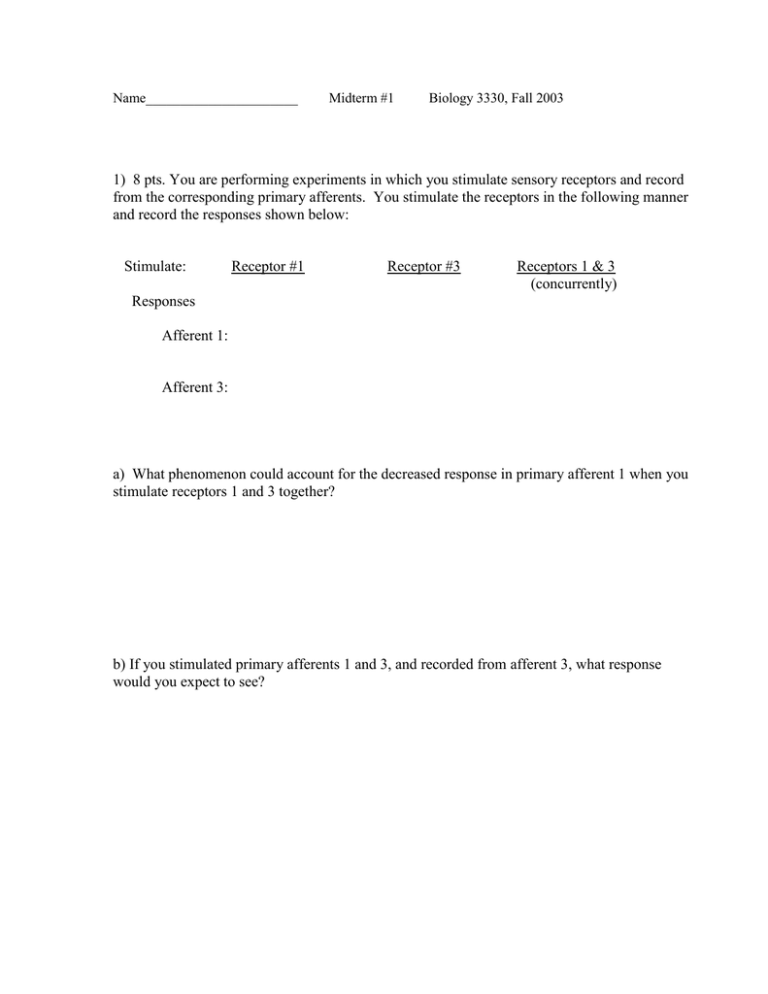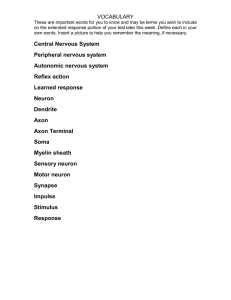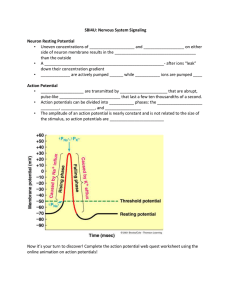1) 8 pts. You are performing experiments in which... from the corresponding primary afferents. You stimulate the receptors...
advertisement

Name______________________ Midterm #1 Biology 3330, Fall 2003 1) 8 pts. You are performing experiments in which you stimulate sensory receptors and record from the corresponding primary afferents. You stimulate the receptors in the following manner and record the responses shown below: Stimulate: Receptor #1 Receptor #3 Receptors 1 & 3 (concurrently) Responses Afferent 1: Afferent 3: a) What phenomenon could account for the decreased response in primary afferent 1 when you stimulate receptors 1 and 3 together? b) If you stimulated primary afferents 1 and 3, and recorded from afferent 3, what response would you expect to see? 2) Using the letters that correspond to the terms on the left, label the CNS regions that the arrows point to. The three pictures below represent sections through which regions (levels) of the brain? A) Dorsal column nuclei B) Ventral horn C) Colliculus D) Pyramidal tracts E) Reticular formation F) Dorsal horn G) Red nucleus H) Substantia nigra 3) (12 pts) For each of the following receptor properties, write I for ionotropic, M for metabotropic, or B for both: ___ Triggers a fast postsynaptic response ___ Triggers a slow postsynaptic response ___ Postsynaptic response is long-lasting ___ Postsynaptic response is short-lasting ___ Binds neurotransmitters such as somatostatin and vasopressin ___ Binds neurotransmitters such as acetylcholine ___ Acts via phosphorylation of an ion channel ___ This receptor can double as an ion channel itself ___ Is important in mediating reflexive behaviors ___ Is important in neuromodulation ___ Acts via a G-protein mediated biochemical cascade ___ Mediates a physical alteration of an ion channel 4) (10 pts) Match the brain area to the symptoms which could result were you to lesion that area: ___Amygdala ___Cerebellum ___Frontal Lobe ___Occipital lobe ___Lateral Spinothalamic tracts ___Glossopharyngeal Nerve ___Oculomotor Nerve ___Reticular Formation ___Substantia Nigra/Basal Ganglia ___ Hippocampus A. Impaired pain sensation B. Inability to hold limbs in a fixed position; tremors C Impaired control of gaze direction D Impaired vision (without damage to the eye itself) E. Emotional ‘flatness’; inability to read emotional states F. Impaired execution of controlled movements (overcorrecting) G. Inability to consolidate new memories H. Impaired taste sensation I. Radical changes in personality and critical thinking J Enduring coma 5) (9 pts.) Matching: __ Serotonin __ Dopamine __ Acetylcholine __ GABA __ Tyrosine __ Catecholamine __ Nitric oxide __ Phosphodiesterase __ Adenylyl cyclase A. converts ATP to cAMP B. sub-class of biogenic amines C. released at neuromuscular junctions D. amine with double ring structure E. retrograde signaling substance F. inhibitory transmitter in vertebrate CNS G. lack of this associated with Parkinson's disease H. produces 2nd messengers IP3 & Diacylgylcerol I. begins synthetic pathway for catecholamines 6) You have a cell in which the following concentrations of ions are present: a) What are the equilibrium potentials for Na+ and K+, respectively? b) At a particular excitatory synapse, you find that the conductances for sodium and potassium are equal (gk=gNa). What is the reversal potential of this synapse? c) You now perform a voltage-clamp experiment in which you hold the membrane potential of the soma at varying voltages and stimulate the presynaptic neuron. You block voltage-gated Na+ channels and delayed-rectifier K+ channels with TTX, and TEA, respectively. Draw the current that you would expect to see at -20mV, -6.5mV, 0mV, 6.5mV and 20mV. 7) EPSPs of equal amplitude are generated on two different dendrites (A and B) of the same neuron. The membranes of the two dendrites have the same specific membrane resistivity and specific membrane capacitance. However, the diameter of dendrite A is 4 times as large as that of dendrite B. a) Plot the amplitudes of EPSPA and EPSPB as a function of distance, and explain your drawing. b) Which EPSP (A or B) would you expect to make a greater contribution in depolarizing the soma? Cite two reasons why you think this would be the case. 8) 10pts The resistive and capacitive properties of a cell can be modeled as an RC circuit, where Erev is the reversal potential, and τ =cm rm is the time constant of the circuit. Consider the 2 cells shown below, which receive synaptic input from the same neuron. You stimulate this presynaptic neuron, and record the results. The time courses of the channels at each synapse are similar; however, the cells themselves differ in their resistive and capacitive properties, and in Erev. You observe that PSPs A and B have the same amplitude, but very different shapes. PSP A rises quickly, but returns to baseline very slowly, while PSP B is symmetric in its rising and falling phases. Given what you know about these cells, what can you say about the relative differences in Erev and τ that would account for these findings? 9) Consider the following situation: You have treated a neuron with TEA to eliminate K+ currents. Normal resting potential for this cell is -70 mV. You then voltage clamp the axon at various clamp potentials and observe the Na+ currents as shown to the right. What do the shapes and relative amplitudes of these current traces tell you in terms of the properties of Na+ channels? 10) 4 pts. The stellate ganglion and giant axon of the squid have played critical roles in enabling the early neurobiologists to understand basic mechanisms underliying synaptic transmission and action potential generation. A) What features of these two aspects of the squid nervous system made them so amenable to experimental analysis. B) What is the neuroethological principle that is revealed here? 11) 10 pts. In your neurophysiological studies of the neural circuit shown below, you discover that the synapses that neuron 1 makes onto neuron 2 show facilitation if presynaptic action potentials occur within 10 ms of each other; if at least 4 such occurrences are required for eliciting spiking in neuron 2. Synaptic depression, however, occurs at the synapse between neuron 2 and 3 when action potentials arrive at intervals less than approximately 5 ms. To better understand the function of this neural circuit, you stimulate neuron #1 in various temporal patterns while recording intracellularly from neurons #2 and #3. Synaptic Facilitation Synaptic Depression a) The spikes elicited in neuron #1 are shown below. Above each of the spike recordings shown below, draw the pattern of postsynaptic potentials and, in some cases, action potentials that you would expect to see in neuron 2 and 3 in response to the patterns of spike activity in neuron 1. Explain your drawings in terms of the effects of synaptic plasticity. neuron #3 __ neuron #2 __ neuron #1 spikes __________________ __________________ _________________ 10 ms b) How would the output of this circuit i.e., the responses of neuron 3, differ if synaptic depression occurred at the first synapse and facilitation was present at the synapse between neuron 2 and 3? c) Would you expect that lowering the calcium concentration in the extracellular fluids might alter the output properties of the original circuit? If so, explain what changes would occur and why? 11. Consider the following situation: You have treated a neuron with TEA to eliminate K+ currents. Normal resting potential for this cell is -70 mV. You then voltage clamp the axon at various clamp potentials and observe the Na+ currents as shown to the right. What do the shapes and relative amplitudes of these current traces tell you in terms of the properties of Na+ channels? 7) A recording electrode is placed into the soma of a neuron. This cell has 3 inputs. Two inputs synapse onto its large lateral dendrite, the third makes a synapse on its apical dendrite. You stimulate the inputs as shown below and observe the results. Responses to stimulating single inputs Responses to stimulating multiple inputs What is a plausible explanation of these results? (what is the nature of these inputs and how do they explain this result?) 8. In your experiments you make an intracellular recording from an unusual type of neuron. As shown below, this neuron produces a spike when you briefly inject 0.1 nA of positive current into it. When you add Magnesium to the extracellular medium, however, the cell fails to generate a spike in response to the 0.1 nA current pulse; now, at least 0.2 nA are required. To further analyze this unusual property you perform a voltage clamp experiment. In this experiment, you block voltage-gated Na and K channels by applying TTX and TEA, respectively. After blocking V-gated Na and K channels, you still observe the currents shown below. You find that these remaining currents are blocked when the Mg concentration is raised. a) What ion type is probably responsible for the currents seen in the V-clamp experiments? Explain your reasoning. b) What do the shapes and relative sizes of the currents observed in the voltage clamp experiments reveal about the properties of these channels and the equilibrium potential for this ion? c) What do you conclude concerning the role of these channels in generating action potentials in this neuron? 9) (6 pts) Consider two neurons that are spherical and lack dendrites; the only process that extends from their somas is an axon that is similar in diameter in these 2 cells. One neuron has a soma diameter of 10 m, the other has a diameter of 20 m. From patch-clamp studies you find that the channel types and densities are very similar in these two neuron types. Correspondingly, these neurons have the same Specific Membrane Resistivity (Rm). a) Would you expect that the time constants of these two neurons are similar or different? Explain your reasoning. b) Should the input resistance of the two neurons differ? If so, by how much? 10) (12 pts) Establishment of the membrane potential: The concentrations of various ions inside and outside of a cell are shown below. a) If Kchannels and Cl channels are now inserted into the membrane, in which direction will K and Cl ions move initially? In your answer, describe the forces that govern this movement . b) What will eventually limit the net movement of these ions across the membrane? What is the equilibrium potential of an ion? c) Eventually, the resting potential will be close to the equilibrium potential of which ion (s)? explain why. (hint, consider the steady-state concentration gradients of these ions). 11) (8 pts) a) What is ‘Muller’s Doctrine’? What does it say about the neural basis of perception? b) What is Synesthesia? How does the condition of Synesthesia extend Muller’s doctrine? 12) (6 pts) Many sensory systems use a ‘range-fractionated’ coding scheme. What are 3 main features of range-fractionated coding that distinguish it from other coding schemes? (consider the nature of the stimulus that is being encoded, and the receptive fields of the sensory cells). 13) (6 pts) How do computational maps differ from noncomputational maps? In your answer, explain what a computational map is?




